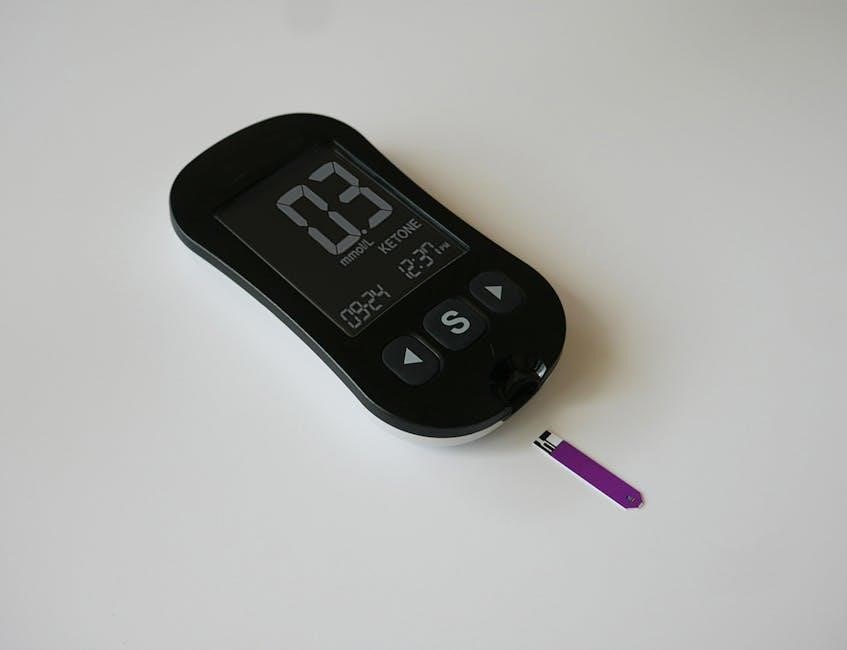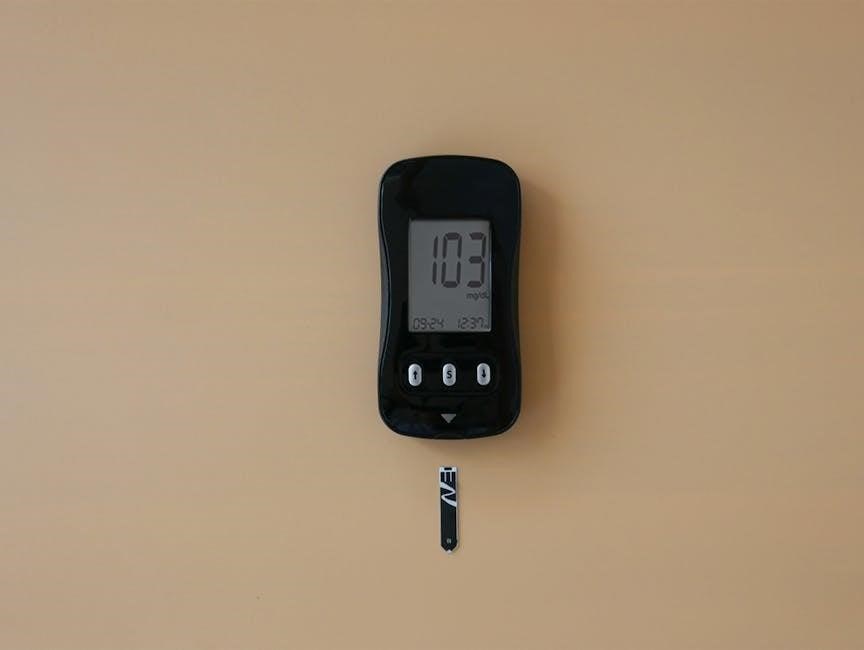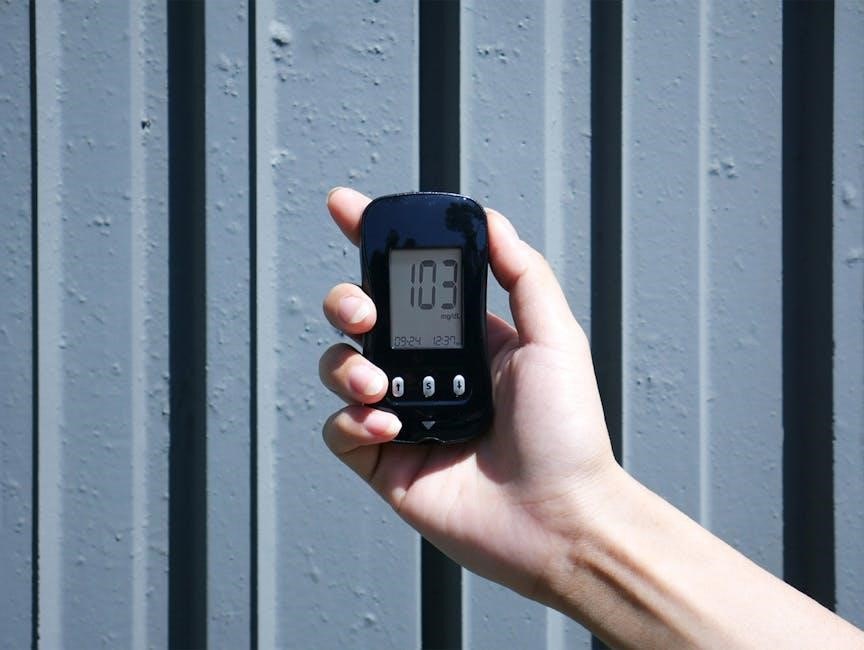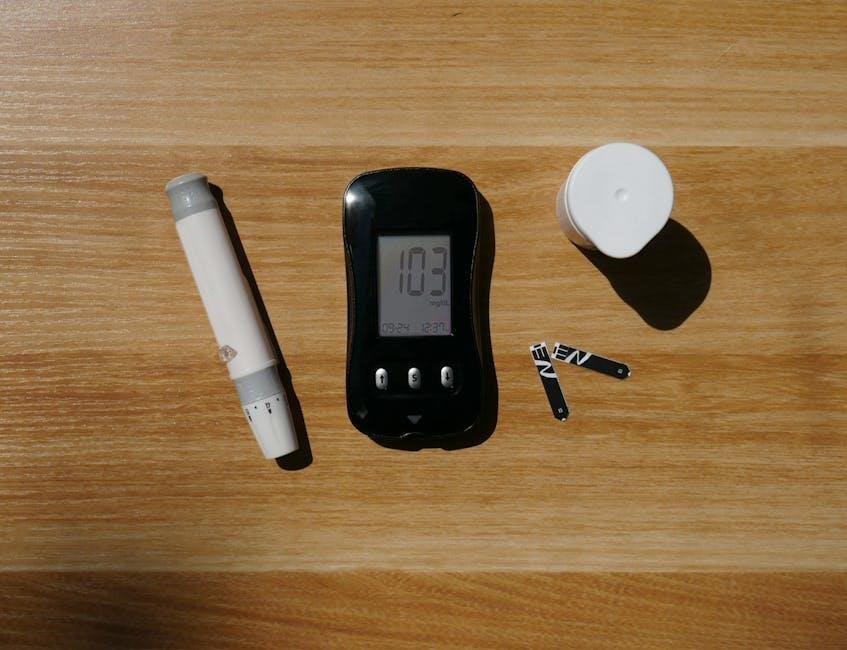The Omron Blood Pressure Monitor is a cutting-edge, user-friendly device designed for accurate home blood pressure tracking. It empowers users to manage their health effectively with smart technology integration.
Importance of Monitoring Blood Pressure at Home
Monitoring blood pressure at home is crucial for maintaining good health, especially for individuals with hypertension or other cardiovascular conditions. Regular readings help detect potential issues early, enabling timely medical interventions. Home monitoring also reduces the need for frequent hospital visits, making it convenient and cost-effective. Omron blood pressure monitors are designed to provide accurate and reliable results, empowering users to take control of their health. By tracking trends over time, individuals can better understand how lifestyle factors, such as diet and exercise, impact their blood pressure. This proactive approach promotes better disease management and overall well-being, making home monitoring an essential part of healthcare routines.

Unboxing and Initial Setup
Unboxing the Omron Blood Pressure Monitor reveals a sleek, user-friendly device. The package includes the monitor, cuff, and quick-start guide, making initial setup straightforward and hassle-free for first-time users.
What’s Included in the Omron Blood Pressure Monitor Package
The Omron Blood Pressure Monitor package typically includes the main monitoring device, a flexible cuff designed for comfortable use, batteries for initial setup, and a detailed user manual. Additionally, some models may come with a storage case to keep the device clean and protected. The monitor itself features a large, easy-to-read LCD display and intuitive buttons for simple navigation. The cuff is usually adjustable to accommodate various arm sizes, ensuring accurate readings for different users. The manual provides step-by-step instructions for setup, operation, and troubleshooting. Overall, the package is designed to offer everything needed for immediate use, ensuring a seamless experience for monitoring blood pressure at home. The inclusion of essential accessories makes it a comprehensive solution for health monitoring.

Step-by-Step Setup Guide
Carefully unbox the Omron Blood Pressure Monitor and ensure all components are included.
Insert the provided batteries into the device, following the polarity indicators.
Locate the adjustable cuff and determine the correct size for your arm.
Wrap the cuff around your bare upper arm, ensuring the tubing is centered and the cuff is at heart level.
Sit comfortably with your back straight and feet flat on the floor.
Turn on the monitor by pressing the power button.
Wait for the device to initialize and display the home screen.
Press the start button to begin the measurement process.
Remain still and silent during the measurement to ensure accuracy.
Once complete, record the reading for future reference.
For models with app connectivity, download the Omron Connect App and follow in-app instructions to sync your device. This setup ensures accurate and convenient blood pressure monitoring at home.

Understanding the Monitor
The Omron Blood Pressure Monitor is a cornerstone of home health management, offering precise readings and intuitive features for users seeking accurate blood pressure tracking.
Key Components of the Omron Blood Pressure Monitor
The Omron Blood Pressure Monitor features a high-resolution LCD display for clear readings, an adjustable cuff for comfort, and a built-in memory function to store previous measurements. The monitor also includes a digital inflation system, ensuring accurate and quick readings. Additionally, it comes with a sleek design, making it portable and easy to use at home or on the go. The device is equipped with advanced technology to detect irregular heartbeats and provide precise systolic and diastolic readings. These components work together to ensure accurate monitoring, helping users maintain better control over their blood pressure and overall health.
How to Properly Use the Cuff
Using the cuff correctly is essential for accurate blood pressure readings. First, ensure the cuff is appropriately sized for your arm circumference. Wrap the cuff snugly around your bare upper arm, positioning the artery marker directly over the inner arm. Avoid twisting or folding the cuff. Sit comfortably with your arm at heart level, supported if necessary. Do not bend your elbow or move your arm during measurement. Ensure the cuff is neither too tight nor too loose, as this can affect accuracy. After inflation, remain still until the measurement is complete. Proper cuff usage ensures reliable readings and optimal performance of the Omron Blood Pressure Monitor.

Calibration and Accuracy
Calibration ensures accurate blood pressure readings by synchronizing the monitor with your artery’s oscillations, a feature that underscores Omron’s commitment to precise and reliable results for better health management.
Why Calibration is Important
Calibration is essential for ensuring your Omron blood pressure monitor delivers accurate readings. Proper calibration aligns the device with your physiological conditions, providing reliable data for health monitoring. Inaccurate readings due to improper calibration can lead to misdiagnosis or inappropriate treatment decisions. Regular calibration ensures consistency and precision, which are critical for tracking changes in your blood pressure over time. Accurate measurements enable better disease management and informed lifestyle choices, contributing to overall well-being. Omron devices are designed to maintain high standards of accuracy, but calibration is necessary to uphold this performance and guarantee trustworthy results.
How to Calibrate Your Omron Blood Pressure Monitor
To ensure accurate readings, follow these steps to calibrate your Omron blood pressure monitor:
- Prepare the Environment: Place the monitor on a flat, stable surface and ensure it is at room temperature. This minimizes environmental interference.
- Power On and Access Calibration Mode: Turn on the monitor and press and hold the “M” or “SET” button until “CAL” appears on the display. This initiates the calibration process.
- Inflate the Cuff: Attach the cuff to your arm as you normally would for a reading. Inflate the cuff to about 20 mmHg above your usual systolic pressure to prepare for calibration.
- Deflate and Adjust: Slowly deflate the cuff while the monitor adjusts its settings. Follow any on-screen instructions to complete this step accurately.
- Complete Calibration: Allow the monitor to finish the calibration process, which may take a few minutes. You will know it’s done when the display confirms completion.
- Test the Monitor: After calibration, turn the monitor off and then back on. Take a test reading to ensure accuracy and functionality.
By following these steps, you ensure your Omron monitor provides reliable blood pressure readings, crucial for maintaining your health and making informed decisions.

Using the Monitor
Turn on the device, ensure the cuff is properly secured, and remain still. Press the start button to begin measurement. The monitor will inflate the cuff, measure your blood pressure, and display the results. Use the memory function to store readings for future reference.
- Always sit comfortably with your arm at heart level.
- Avoid movement or talking during measurement for accuracy.
- Take multiple readings for consistent results.
Regular use helps track your blood pressure trends effectively.
Preparing for Measurement

To ensure accurate readings, prepare a quiet and comfortable environment. Sit in a relaxed position with your back supported and feet flat on the floor. Avoid eating, drinking, or smoking for at least 30 minutes before measurement. Remove tight clothing that may restrict your arm. Place your arm on a flat surface at heart level. Avoid talking or moving during preparation, as this can cause inaccurate results. Wait 5-10 minutes if you’ve recently exercised or are feeling stressed. Ensure the cuff is properly sized for your arm, as an ill-fitting cuff can lead to incorrect readings. Press the power button to turn on the monitor and let it complete its self-test before proceeding.
- Relax and avoid stress for at least 5 minutes.
- Position your arm correctly at heart level.
- Ensure the cuff is the right size for your arm.
Proper preparation helps ensure reliable and consistent blood pressure readings.
How to Take an Accurate Reading
To take an accurate reading, ensure the environment is quiet and you are seated comfortably with your back supported. Place your arm on a flat surface at heart level, with your palm facing upward. Wrap the cuff snugly around your bare upper arm, avoiding tight clothing that may interfere. Press the power button to turn on the monitor and wait for the self-test to complete. Remain still and silent during the measurement process. The monitor will inflate the cuff and then gradually deflate it, taking your reading. Avoid moving or talking, as this can cause inaccurate results. Once complete, the monitor will display your systolic, diastolic, and pulse readings. For best accuracy, consider taking a second measurement a few minutes later and averaging the results.
- Stay still and silent during measurement.
- Ensure the cuff is snug but not overly tight.
- Take a second reading if needed for accuracy.
Following these steps ensures reliable and precise blood pressure readings every time.
Understanding Your Blood Pressure Readings
Your Omron blood pressure monitor displays two main numbers: systolic (top) and diastolic (bottom) pressure. Systolic measures pressure when your heart beats, while diastolic measures it at rest. A third number, pulse rate, shows heartbeats per minute. The monitor may also include a color-coded indicator to help interpret readings: green for normal, yellow for elevated, and red for high blood pressure. Normal readings are typically below 120/80 mmHg. Elevated readings (120-129/80) may indicate potential issues, while higher readings (130/80 or above) suggest hypertension. Tracking these readings over time helps identify trends and supports better health management. Always consult a healthcare professional if readings are consistently high.
- Systolic (top number): Heartbeat pressure.
- Diastolic (bottom number): Resting pressure.
- Pulse: Heart rate per minute.
- Color codes: Quick interpretation of results.
Regular monitoring and understanding these values can help you maintain better cardiovascular health.

Maintenance and Troubleshooting
Regularly clean the monitor with a soft cloth and avoid harsh chemicals. Check the cuff for damage and ensure proper storage. Replace batteries as needed and refer to the manual for error codes. Proper maintenance ensures accurate readings and extends device life.
Cleaning and Maintaining Your Monitor
To ensure optimal performance, regularly clean the Omron blood pressure monitor with a soft, dry cloth. Avoid using harsh chemicals or abrasive materials, as they may damage the device. Check the cuff for signs of wear or cracks and replace it if necessary. Store the monitor in a cool, dry place, away from direct sunlight. For battery-powered models, remove batteries if the monitor will not be used for an extended period to prevent leakage. Refer to the manual for specific maintenance guidelines to keep your device in excellent condition and ensure accurate readings over time.
Troubleshooting Common Issues
If your Omron blood pressure monitor isn’t functioning correctly, check for common issues. Ensure the cuff is properly sized and securely fastened, as incorrect placement can lead to inaccurate readings. If the monitor displays an error code, refer to the manual for specific solutions. Low battery or incorrect battery installation may cause malfunctions; try replacing or reinserting batteries. If the device still doesn’t work, restart it or reset to factory settings. For persistent problems, contact Omron customer support or consult the troubleshooting section in your manual. Regular maintenance and proper usage can help prevent many common issues and ensure accurate measurements.

Advanced Features
The Omron blood pressure monitor offers advanced features like memory storage, multi-user support, and Bluetooth connectivity, enabling seamless data tracking and sharing via the Omron Connect app.
Using the Memory Function
The Omron blood pressure monitor’s memory function allows you to store multiple readings, making it easier to track your blood pressure over time. Most models can store up to 60 readings, with some advanced versions supporting multiple users. This feature helps in identifying trends and patterns in your blood pressure, which is crucial for managing hypertension. To use the memory function, simply take a reading as usual, and the monitor will automatically save the data with the date and time. You can review stored readings by navigating through the menu, providing a clear overview of your progress. This function is particularly useful for sharing data with healthcare providers, ensuring informed decisions about your health.
How to Use the Omron Connect App
The Omron Connect App is a convenient tool that connects your blood pressure monitor to your smartphone or tablet. To use it, download and install the app from the App Store or Google Play. Create an account or log in if you already have one. Pair your monitor with the app via Bluetooth by following the in-app instructions. Once connected, your blood pressure readings will automatically sync to the app, allowing you to track your data over time. The app provides detailed graphs, averages, and trends, helping you monitor your progress. You can also set reminders to take readings and share your data with healthcare professionals for better management of your health.
Consistent blood pressure monitoring is crucial for maintaining health. The Omron monitor empowers users with accurate data, enabling informed decisions. Regular use supports a healthier lifestyle.
Final Tips for Optimal Use

For the best experience with your Omron Blood Pressure Monitor, measure at the same time daily, ideally morning and evening, for consistent tracking. Avoid caffeine, alcohol, and exercise 30 minutes before measurement. Sit comfortably with your back straight and feet flat on the floor. Ensure the cuff fits properly and is at heart level. Record your readings in the memory or app for long-term tracking. Regularly calibrate the monitor and replace the battery when needed. Clean the device gently with a soft cloth. By following these tips, you’ll maximize accuracy and enjoy a seamless monitoring experience, empowering you to manage your health effectively over time.
Why Choose Omron for Blood Pressure Monitoring
Omron is a trusted leader in blood pressure monitoring, offering unmatched accuracy, reliability, and innovation. With over 40 years of expertise, Omron devices are clinically validated and recommended by healthcare professionals worldwide. Their advanced technology, such as IntelliWrap and IntelliSense, ensures precise readings and comfort. Omron monitors are user-friendly, with large displays and connectivity to the Omron Connect app for seamless tracking. They also offer a wide range of models to suit different needs, from basic to advanced features. Choosing Omron means investing in a high-quality, durable product that supports your long-term health management. Trust Omron for accurate, reliable, and easy-to-use blood pressure monitoring solutions.
